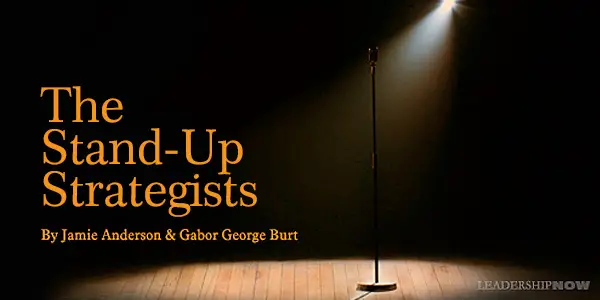 |
 |
12.08.17

The Stand-Up Strategists
H Skilled leaders, those we call the “Stand-Up Strategists,” understand the utility of humor to address four important organizational outcomes, or the 4Cs: Community, Composure, Change and Creativity. And to address these four outcomes they typically use four broad styles of humor. The 4S – Styles of Humor The four styles we identified are based on our understanding of humor-driven dynamics in organizations, and build upon the broader world of humor research: Sensory humor involves a leader projecting an energetic, positive, playful vibe, and having a generally humorous outlook. Social humor typically involves jokes or stories shared as a tool to reduce interpersonal tension, increase sociability and promote openness. Self-deprecating humor is the ability of a leader to laugh at him/herself to reduce power-distance, and thereby facilitate more positive and intimate relationships. Strong humor most often entails sarcasm or cynicism. It is the comic style mostly associated with generating negative emotions, and therefore the one with the most limited application in organizations. The 4Cs – Organizational Outcomes There are four organizational outcomes where humor can be leveraged as a particularly effective managerial tool: Community In situations in which collaboration is an important driver of organizational success, lacking a sense of community can be a formidable barrier to delivering results. It is well understood by psychologists and social scientists that people who laugh together generally have stronger feelings of empathy and bonding. Sense of fun and social humor can be used as especially effective humoristic styles to build group cohesiveness, with a leader as the role model of projecting a relaxed and humorous attitude, sharing occasional jokes, anecdotes and stories that inject a playful aspect to day to day interactions. In situations where a leader needs to increase sociability across organizational hierarchies, self-deprecating humor can also be used. In years gone by, strong 'community' humor might have involved humiliation, ridicule, sexist or even racist overtones but these kind of jokes, anecdotes and stories have no place in today’s world. Beyond being potentially damaging to one’s own reputation, inappropriate humor can also contribute to reduced morale, absenteeism, the elevation of dysfunctional internal competition, and company-level reputational damage. Composure Studies on humor, stress and coping strategies have shown that individuals with a high sense of humor tend to experience less stress than individuals with a low sense of humor, even in situations where both face similar challenges. In group situations, humor can be utilized to reduce the pressure of stress associated with deadlines, targets or crises. Social humor is best leveraged in these situations, not to make deadlines or challenges disappear, but to improve morale, to help individuals avoid feelings of isolation, and to increase the solidarity of purpose needed to overcome adversity. Due to its tendency to trigger negative emotions, strong humor should be used sparingly, and in most instances only ever directed at external targets where there is an urgent need to overcome complacency or strong internal inertia. Change It is important for all leaders to communicate with employees about ongoing organizational change, especially with regards to vision and strategic priorities. Humor in day-to-day interactions and broader organizational communication can create an atmosphere which improves listening and understanding, boosts message retention, and enables positive emotions. These outcomes are even more vital during times of continuous change - two of the most common reasons that employees resist change are lack of sufficient information and a fear of the unknown. In the words of writer and civil rights activist Maya Angelou: “I’ve learned that people will forget what you said, people will forget what you did, but people will never forget how you made them feel.” Creativity The fourth organizational condition addressed by humor is perhaps the most important: creativity. Humor, laughter and fun releases physical and cognitive tension, which can lead to perceptual flexibility—a required component of creativity, ideation, and problem solving. Discoveries in this area also explain why many leaders are not just leveraging humor, but are also investing in creating playful and fun work environments. Jumping to conclusions… Time and time again in our interactions with leaders in some of the world’s most successful and innovative companies we have been struck by a recurring experience – not only are these leaders intelligent, talented and forward-thinking, many of them are also very funny. And it is not just that these senior executives are able to deliver a flawless punchline at a cocktail reception or town hall event – they are able to leverage humor as a strategic tool. May the farce be with you!  Of Related Interest: “When you’re a high performer, when you’re an achiever, the doors open in front of you.” “It’s great to strive for success, to shoot for the moon. But there are many moons out there in the Universe, so please make sure that the moon you are shooting for is your own.”
Posted by Michael McKinney at 08:02 AM
|
BUILD YOUR KNOWLEDGE
 

How to Do Your Start-Up Right STRAIGHT TALK FOR START-UPS 
Grow Your Leadership Skills NEW AND UPCOMING LEADERSHIP BOOKS 
Leadership Minute BITE-SIZE CONCEPTS YOU CAN CHEW ON 
Classic Leadership Books BOOKS TO READ BEFORE YOU LEAD |